The citizen participation process including presentations, discussions, public hearings, letters and comments has been long and arduous. The issues are complicated and sometimes feelings run high. In such situations, there can be a feeling that citizens have not been heard. This document, “Guide to Zoning Amendments Related to Multifamily Uses and Mixed-Use“, summarizes many of the issues that have been raised and the changes that have been made in the zoning Articles as a result of the citizen participation in the public review process. Citizens have been heard.
Related articles
Many issues are under discussion as a result of these proposed zoning Articles. Issues include: housing affordability, the diversity of housing and incomes in Arlington, environmental concerns and sustainability, tax burdens or tax savings potentially resulting from growth, the risk of postponing the decisions, and the image of Arlington as a community that values diversity and equitability. This one page “fact sheet” attempts to address many of these issues and concerns.
Interview with Aaron Clausen, AICP; City of Beverly, Director, Planning and Community Development
Rather than express generalized worry about the “lack of affordable housing”, Peabody, Salem and Beverly have created an intermunicipal Memorandum of Mnderstanding (MOU) to very specifically define and target the problem and the population they want to address.
According to Aaron Clausen, “There is a fair amount of context that goes along with the MOU, but primarily the communities got together as sort of a coalition to survey and understand what was going on relative to homelessness. What came out of that is a recognition that there is not enough affordable housing generally, and particularly transitional housing, or more specifically permanent supportive housing.
“Salem and Beverly both have shelters, however the shelters were basically serving as permanent housing (and running out of space). That won’t help someone into a stable housing situation. Anyway, this was the agreement (attached MOU) and the good news is that it has resulted in affordable housing projects; one is done in Salem for individuals and Beverly has a 75 unit family housing project permitted and seeking funding that has a set aside for families either homeless or in danger of becoming homeless.
“There is also a redevelopment of a YMCA in downtown Beverly that will increase the number of Single Room Occupancy units. I wouldn’t say that the MOU got it done by itself but it helps demonstrate a regional approach. ”
To see the actual Memorandum of Understanding between these three municipalities to address affordable housing, particularly for people who are homeless or at risk of homelessness, click HERE.
The calculation for what is permanently affordable housing is complicated. Arlington’s affordable rate is based on a region that includes the Area Median Income (AMI) of the Cambridge-Boston-Quincy region. The rate is adjusted and reset periodically according to federal HUD guidelines. The rate is applied based on family size and on the Town’s definition of what income level is eligible for Inclusionary Housing opportunities in Arlington. In Arlington a 3 person family would qualify if their income was under 60% of AMI. At this time, that is approximately $58,000 for a family of three.
For more information, see this table of income limits from Cambridge’s Community Development Department, and this short paper on affordable housing from the City of Boston.
by Annie LaCourt
One of the concerns people have about the current MBTA Communities zoning proposal is the effect that the increase in housing will have on the town’s budget. Will the need for new services make demands on our budget we cannot meet without more frequent overrides? Or will the new tax revenues from the new buildings cover the cost of that increase in services?
The simple answers to these questions are
- No: It will not make unmanageable demands on the budget; and
- Yes: the new tax revenue from the multi-family housing anticipated will cover the costs of any new services required.
Adopting the current MBTA Communities zoning proposal may even slow the growth of our structural deficit, as I will show in more detail using as examples some of the more recent multi-family projects that have been built in Arlington.
How Does Our Budget Work and What is the Structural Deficit?
First, some basic facts about finance in Arlington: Like every other community in Massachusetts, Arlington’s property tax increases are limited by Proposition 2.5 to 2.5% of the levy limit each year. What is the levy limit? It’s all of the taxes we are allowed to collect across the whole town, without getting specific approval from the Town’s voters. For FY 23 the levy limit is $135,136,908. $3,271,996 of that is the 2.5% increase we are allowed under the law. But also added to that is $1,202,059 of new growth, which comes from properties whose assessment changed because they were substantially improved–either renovated or by increasing capacity. When we reassess a property that has a new house or building on it, we are allowed to add the new taxes generated by the change in value of the property to the levy limit.
Property taxes make up approximately 75% of the town’s revenue. So – except for new growth – that means that the bulk of our budget can only grow 2.5% a year. Other categories of income like State Aid have a much less reliable growth pattern. If the state has a bad fiscal year, our state aid is likely to remain flat or decrease.
Expenses
On the expense side, our default is a budget to maintain the same level of services year to year. We cap increases in the budgets of town departments by 3.25% and the school budget by 3.5%, save for special education costs which are capped slightly higher.
We also have several major categories of expense that are beyond our control that increase at a greater rate than 2.5%. These include, among other things, funding our pension obligations, health insurance costs and our trash collection contract.
Structural Deficit
This difference between the increase in revenues and the increase in costs is the structural deficit. It’s structural because we can’t cut our way out of it without curtailing services severely and we can’t stop paying for things like pensions and insurance that are contractual obligations.
The question of how MBTA communities zoning will affect this is crucial. So let’s take a deeper dive, first on revenue and then on expenses.
How Will MBTA Communities Affect New Growth?
How MBTA-C zoning will affect new growth depends on what gets built and at what rate. Let’s consider some real world examples:
882 Mass Ave. used to be a single story commercial building. It was assessed at $938,000 and the owner paid approximately $9,887 in taxes annually. It has been rebuilt as a mixed use building with commercial space on the ground level and 22 apartments on 4 floors above. The new assessment is approximately $4,800,000 and the new tax bill is about $54,000.00. That means $45,000 in new growth – new property taxes that will grow at the rate of 2.5% in subsequent years.
Another example is 117 Broadway. The building that used to be at that address was entirely commercial, assessed at $1,050,000 and paid around $11,770 in taxes annually. After being rebuilt as mixed use by the Housing Corporation of Arlington, it is assessed at $3,900,000 and taxed at $43,719. 117 Broadway has commercial on the ground floor and 4 stories of affordable housing above. The new growth for this example is approximately $30,000.
What these examples show, and our assessor believes is a pattern, is that a new mixed use or multi-family building increases the taxes we can collect by as much as 400%, depending on the kinds of housing units.
So we can expect new development under MBTA Communities to increase the levy limit substantially over time, reducing the size and frequency of future tax increases.
How Will This New Housing Affect the Cost of Services?
Of course, with new residents comes a need for additional services. However, town-provided services will be impacted differently. Snow and Ice removal, for example, will not be affected at all – we aren’t adding new roads. Many other services provided by public works are like snow and ice: They would only increase at a faster rate if we added more land area or more town facilities to the base.
Services like public safety and health and human services may see gradual increases in service requests, as more people place more demand on these departments. Right now we have a patrol officer for every 850 or so residents. This means we might need to add a new patrol officer if the population increases by 850 residents. But it’s not clear that a new officer would be needed; it depends on the trends the police department sees in their data. I think of these services as increasing by stair steps: Adding a few, or even a few hundred, residents doesn’t require us to add staff to provide more services. Adding a few thousand might mean we need to add a position but we will have added a great deal to the levy limit before we need to add those positions.
Trash Collection Impact
There is one town service that sees an impact every time we add a new unit of housing – trash collection. The town spends approximately $200 per household on solid waste collection and disposal. As mentioned above, 882 Broadway has 22 new 1 bedroom and studio apartments. When that building was all commercial the businesses paid privately for trash removal. The new trash collection costs will be at least $4,400 annually. It’s possible, however, that the building will need a dumpster and that could cost up to $20,000 annually. Either way the new revenue ($45,000) outstrips the increased costs. The town is working on creative solutions for new buildings to keep this cost as affordable as possible.
What About Schools?
Regardless of new housing construction, our student population ebbs and flows. Families move in with small children who go through the school system. The kids graduate high school but their parents, now in their 50’s or 60’s, don’t move until they are much older and need a different living situation. When they sell their homes, the new owners are likely to be families with children again. We can see a pattern of boom and bust in our school population if we look back. Right now, we are seeing a drop in elementary population as this cycle plays out again. We now have 221 fewer students enrolled in the elementary schools than we did in 2019.
We account for this ebb and flow in the budget. A number of years ago, we set a policy to add a growth factor to the school budget. We increase the budget by 50% of per pupil costs for each new student. Currently that is $8800.00 per student. But the policy works in reverse as well. We reduce the budget by the same amount per child as the student population wanes. We also see increased state aid under chapter 70 when our student population grows and may see reductions if it shrinks.
Will Multifamily Homes Add Students?
The new multi-family housing generated by MBTA communities zoning may add students to our schools – but not as many as you might think. Other large multi-family developments like the Legacy apartments and the new development at the old Brigham site have not added a lot of children to the schools directly. Going back to our two example buildings, 882 Mass Ave is all studio and 1 bedroom units, so we are unlikely to see children living there. Our MBTA communities zoning, however, must by law allow new housing that is appropriate for families. So for planning purposes, it’s best to assume we will see growth in the school population.
So what will the effect of this new housing be on the school population and our budget? Given that the new housing will be built gradually, it’s more likely to stabilize our student population than precipitously increase it. The same will be true for our budget: We will see some increases in the school budget growth factor but also increases in state aid and increases in tax revenue from the new construction.
Conclusions
If we create an MBTA communities zone per the working groups recommendation or something close to that, we will see the effect on our budget over time, not immediately. Even if the zone has a theoretical capacity of 1300 additional units (total capacity minus what is already there) the development of new housing won’t be abrupt. For budget purposes, we project our long range plan five years into the future.
When we get to a year, say FY 2023, the actual state of our budget never looks exactly like the projection created five years earlier. We cannot predict the future very far out. What we can do is look back and see what the effects of previous development have been on our budget, and we can assess the risks of our decisions. Experience tells us that multi-family development doesn’t break the budget or swamp the schools, even when the developments are large. It also tells us that turnover in the population causes ebbs and flows in the school population, regardless of new development. We can say with certainty that multi-family development increases our revenues through new growth, and that past experience has been that that new growth mitigates the need for overrides.
My conclusion is that the new development that will occur if we create a robust zone that allows multi-family development by right, will at worst give us growth in our revenues that keeps pace with any increase in services we need. At best, those new revenues will outstrip the growth in expenses and help mitigate our structural deficit. The risk of allowing this new growth is low, and the rewards are worth it, in the form of new missing middle housing, climate change mitigation, and vibrant business districts fueled by new customers nearby.
(Elliot L. is an 8th grader at the Ottoson Middle School)
In the middle of COVID-19, I started to notice a large construction project happening right down the street in our little neck of the woods by Thompson school. I simply assumed it was another apartment building, but after asking the adults of my community, I found it was much more impactful than that. Arlington was supporting a large affordable housing project to be established, along with plans of putting Arlington EATS, a food pantry, below it. This got the gears in my tiny sixth grade mind churning. I began asking questions like: how do you apply to live there? How much does it cost? Do the owners provide you with furniture? Of course, most of those questions were answered by my parents, and then quickly put in the back of my mind. However, the idea of affordable housing stuck with me, especially when you can see it from your front porch. Upon reaching the 8th grade, where I am now, I found myself and every student in my class presented with a year long project trying to make change in Arlington. This assignment, called the Civics Action Project, or CAP, guides students to choosing a local issue they wish to address.
The premise got me thinking. How can I help my community with our rising cost of living and need for affordable housing? Initially, the other students and I were overwhelmed by the magnitude of the issue, and had trouble thinking of a reachable solution.
Despite this, a small group of classmates and I were intrigued by a bill mentioned by Claire Ricker, Arlington’s director of Planning and Community Development, during an informational panel. Ms. Ricker talked about the MBTA Communities Act, a law requiring Arlington to create higher-density housing near the T. We knew we had found our goal, to raise awareness and support zoning for affordable housing as part of the act.
However, as our research continued, we learned of the real function of this legislation. The goal of the MBTA communities act is to build more compact middle income housing. This will make it so people like young adults and downsizers can come to live in this town, building their future and contributing to a diverse community. This is an essential step in the right direction for the town, but our strides need to be longer.
In order to support our goal, we still wanted to learn more about Arlington’s affordable housing needs. We wanted to promote those issues, as well as the missing middle housing we desperately need. Our group started by conducting a survey that we posted on Arlington forums, along with directly sending it to as many people as we could. 60 residents responded, and we then shared these results with Select Board member Len Diggins. Here are some of the most interesting results of this survey!
- Many people in Arlington still struggle with home, food, and job insecurities.
- The cost of living has made almost every family surveyed have to change their lifestyle in some way.
- Over 1/3 of Arlington residents believe their salary is not enough to support their families.
- 87% of people think Arlington government is making a subpar effort at combating these issues.
- When asked what they would like to see the town do, Arlington residents supported the idea of building more affordable housing and providing aid and support to local food distribution groups, such as Foodlink or Arlington EATS.
- About half of residents have heard of and know about the MBTA communities act.
After the results of our survey, along with other actions taken to learn more about the MBTA communities act, my group and I came to a conclusion of our plan: In order to try and make a change in Arlington, we were going to spread the word to as many adults as we could in order to support both the higher-density housing the MBTA communities act is focused on, and lower cost housing. While these are separate things, our thinking is that the more people who can vote and hear about this, the more willing they will be to connect and support the different pieces of the puzzle to solve our housing issue. This is not just a one-time thing. The MBTA communities act is a planned, strategic opportunity to make Arlington a better place for the future. We hope with the information provided, you will also keep the cause of affordable housing progressing as well. Thank you for reading!
(By Vince Baudoin and James Fleming)
Could Arlington be better using its curb space? Here are some ways the curb can be used to create green infrastructure, promote public safety and accessibility, support sustainable transportation, strengthen business districts, and enable new ‘car-light’ development.
Roughly six inches high and made of concrete or granite, the curb marks the edge of the roadway, channels runoff, protects the sidewalk, and gathers stray leaves. When not assigned any other use, the space in front of the curb it usually serves as free storage for personal automobiles.
Yet the humble curb is a limited resource that can serve the community in many more ways. Have you thought about how your town budgets its curb space? For that matter, has your town thought about how it budgets its curb space?
While Arlington mostly uses its curb space for parking, some areas have other curb uses designed to achieve a specific goal. Consider the streets you use often. Have you seen an unsolved problem, or a missed opportunity, that a different use of the curb could help solve?
Create green infrastructure
The Town has miles of paved roadway. When it rains or snows, water runs into storm drains, carrying salt, oil, and other pollutants with it. The storm drains dump these pollutants directly into long-degraded waterways such as the Mill Brook, Alewife Brook, and the Mystic River. The Public Works department struggles to keep grates clear and drains from overflowing.
One solution: Use the curb for more greenery! The curb can be extended to create a rain garden or tree planting strip. The rain garden helps slow runoff and filter the water before it enters the drain, while trees benefit from additional room for the roots to grow without damaging the sidewalk. A side benefit: narrowing the street encourages drivers to slow down, making neighborhoods safer.
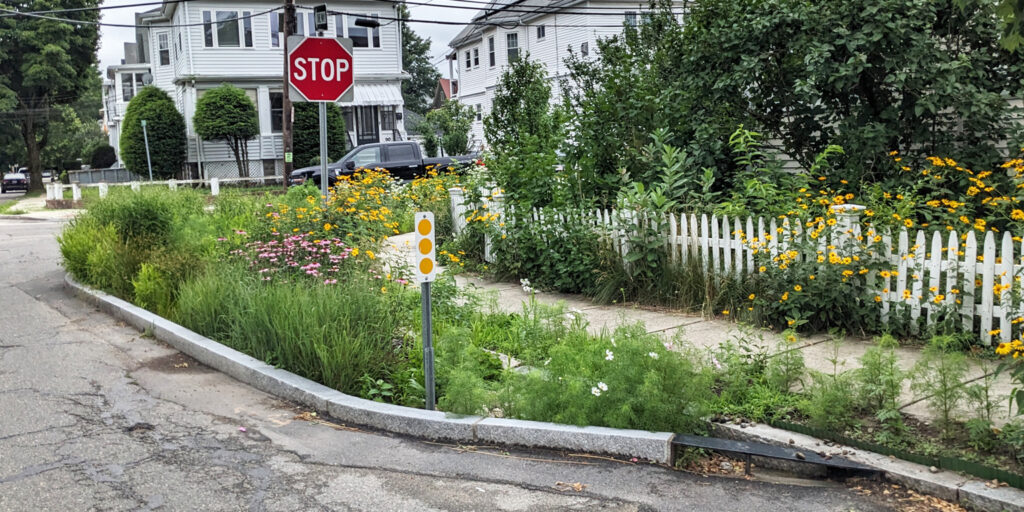
Promote public safety and accessibility
Often, portions of the curb are set aside for public safety purposes. For example, a fire lane provides fire department access to key buildings, such as the high school, shown below. Fire hydrants also enjoy special curb status.
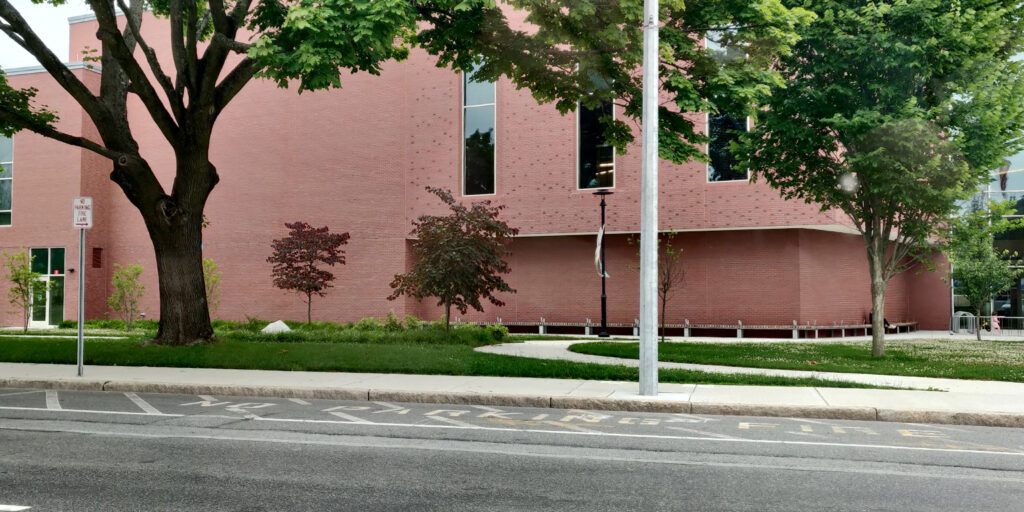
Other times, no-parking zones are established to enhance the free flow of traffic, such as here at Broadway Plaza:
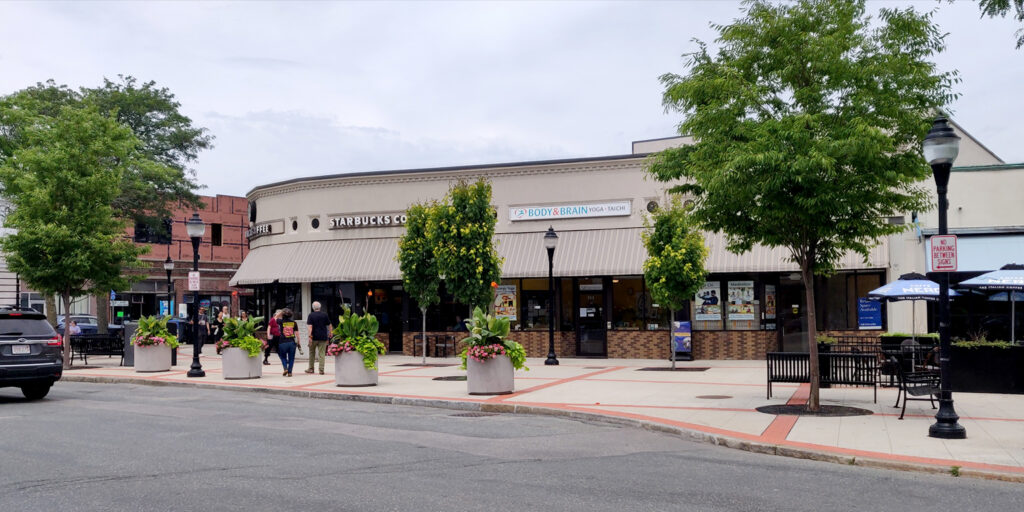
Where pedestrian crosswalks are present, a curb extension is a key safety enhancement. By narrowing the roadway, the curb extension encourages drivers to slow down and look for pedestrians. For pedestrians, it reduces the distance they must cross and prevents cars from parking directly next to the crosswalk and blocking visibility.
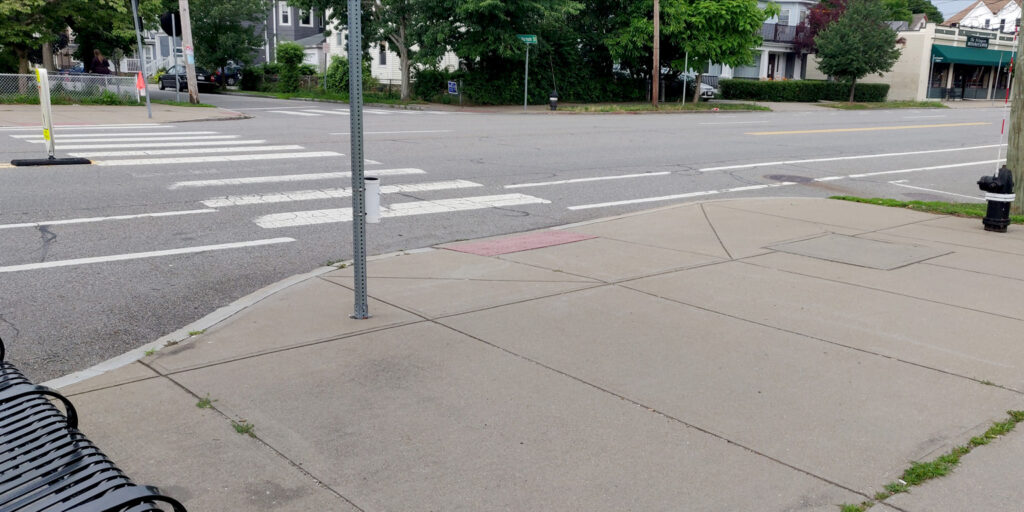
Finally, accessible parking spaces can be created along the curb. Arlington has at least 50 designated permit-only on-street parking spaces that provide convenient parking for residents with mobility issues or other disabilities.
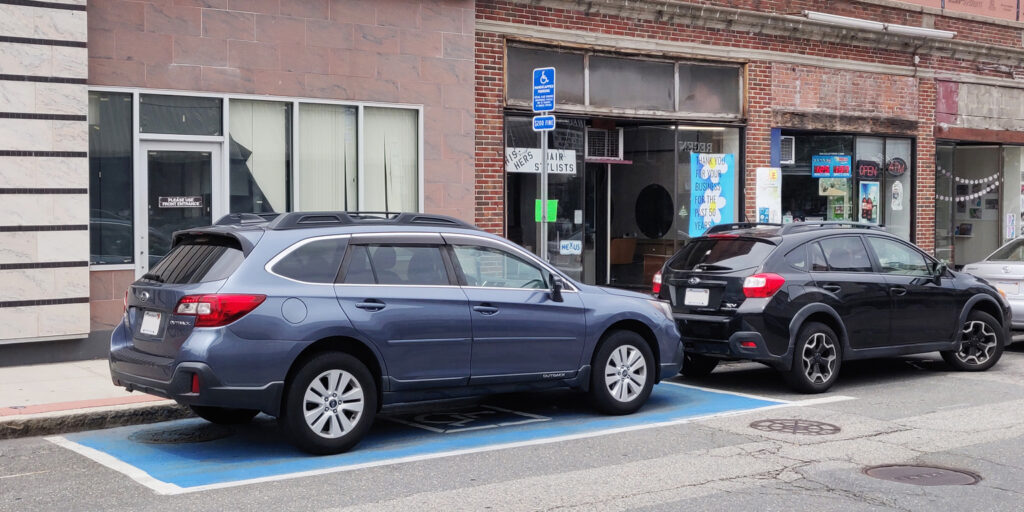
Support sustainable transportation
When the curb is mostly used for cars, it is easy to overlook how curbside facilities can enhance other forms of transportation.
In the space of one or two parked cars, this bikeshare station offers space for 11 bikes. However, because it is installed on the roadway, it must be removed every winter so that snow can be cleared. If the curb were extended, the bikeshare station could be used year-round. Another nice feature is bicycle parking: the space to park one car can be used to park six or more bicycles.
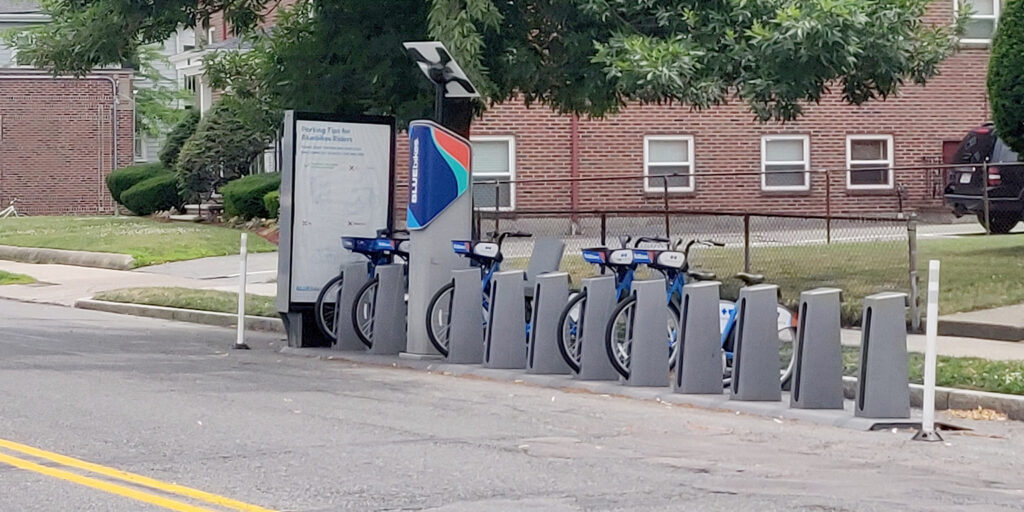
A bus stop allows buses to pull to the curb. In some cases, it is appropriate to extend the curb so the bus would stop in the traffic lane; otherwise, it may experience delays when it merges back into traffic.
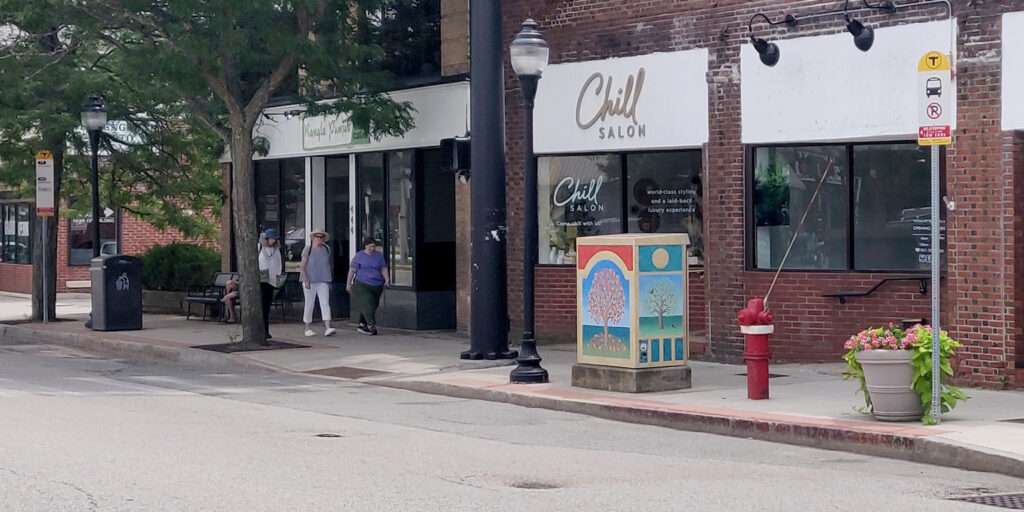
A bus priority lane provides a dedicated right of way for buses, helping to improve on-time performance. To date, these lanes extend only a few hundred feet into Arlington along Mass Ave. They have proven beneficial in many other communities.
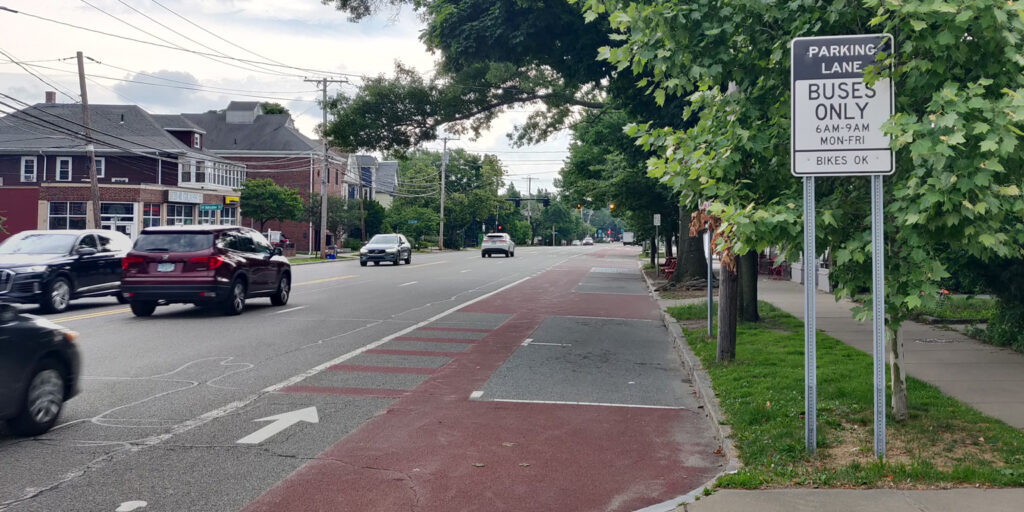
Bike lanes, particularly if they are separated from cars by a physical buffer, greatly enhance the safety and comfort of people traveling on two wheels.
But with a limited roadway width, adding bike lanes is difficult unless the community is flexible enough to consider consolidating curb parking on one side of the street, or moving it to side streets entirely.
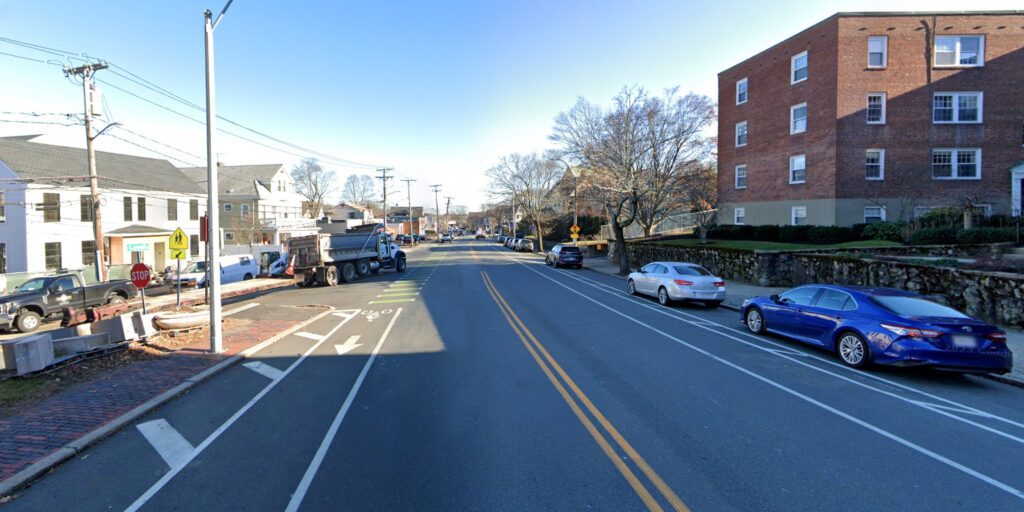
Finally, the Town could expand the use of on-street spaces for electric vehicle charging stations, such as this one on Park Ave:
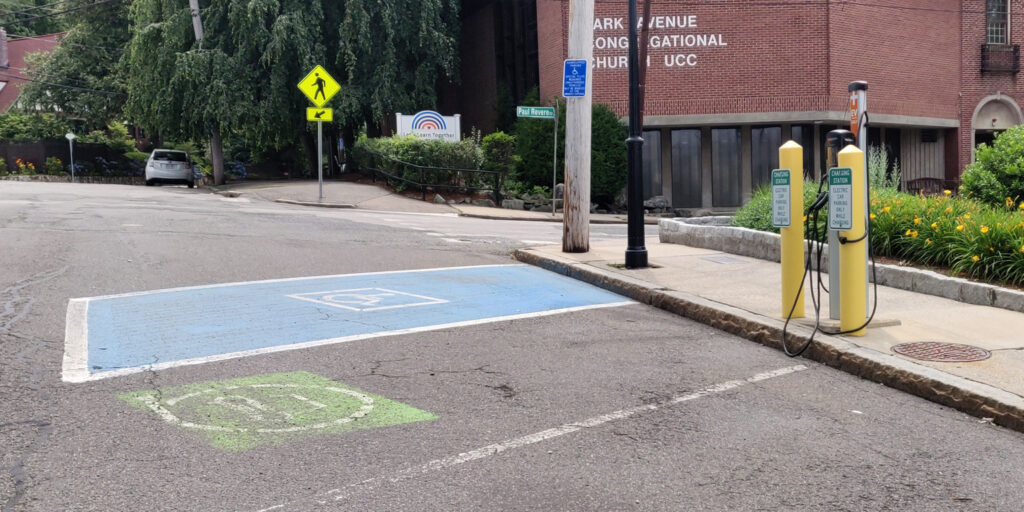
Strengthen business districts
Nowhere is the curb more valuable than in business districts. Businesses thrive when their customers have a convenient way to reach them. Metered parking encourages people to park, do their business, and move along so another patron can take that space. Revenue from parking meters can be spent to improve the business district–for example, by planting flowers and trees.
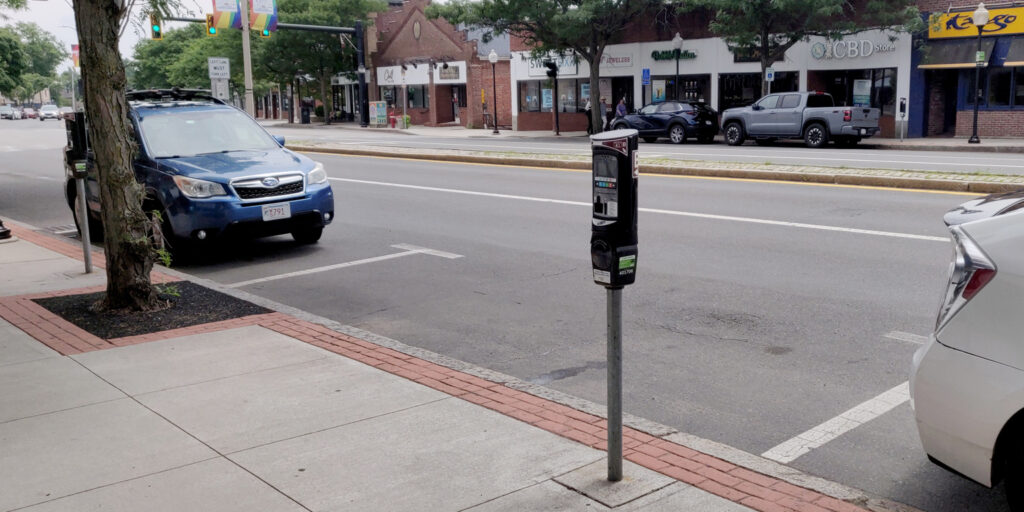
Metered parking is not the only valuable use of curb space in a business district. Outdoor dining is a way the Town can directly support its restaurants by enabling them to serve additional customers. Here is one example in Arlington Center:
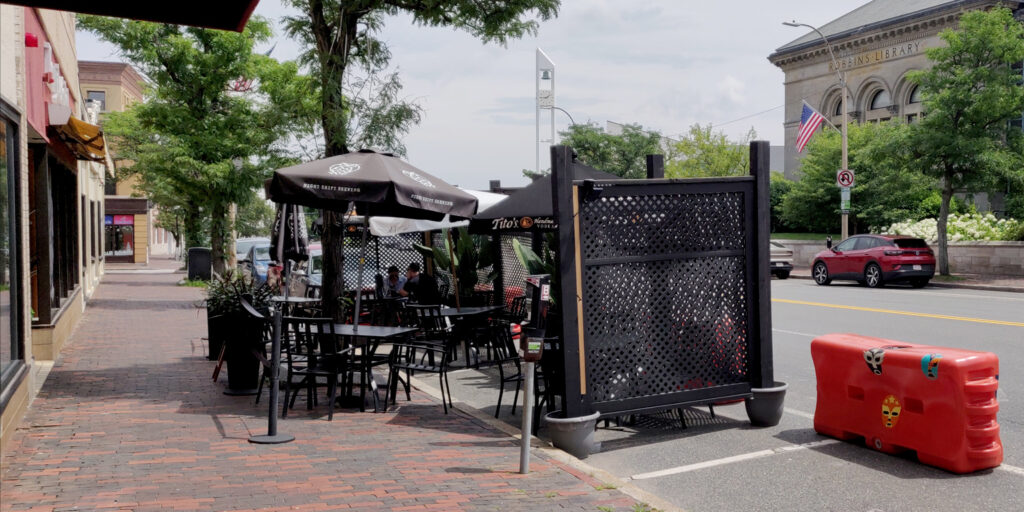
And in Arlington Heights:
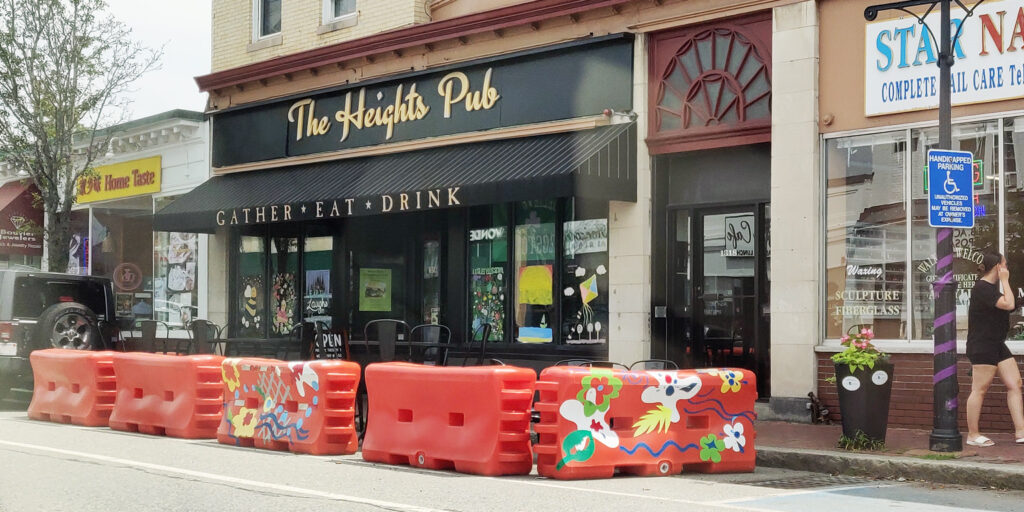
Other valuable curb uses in business districts include taxi stands and loading zones. Loading zones in particular are crucial to businesses’ success and help prevent the street from being clogged by early-morning delivery trucks, late-night food-delivery vehicles, and everything in between.
Enable new ‘car-light’ development
With high housing costs and a relatively small commercial tax base, Arlington could benefit from some kinds of development. However, land is valuable and lots are small, so if new buildings are required to have large parking lots, it is very difficult to build new homes and businesses. Plus, large parking lots bring more cars and more traffic. But better curb management can help resolve this dilemma, supporting car-light development that is more sustainable and affordable.
For example, on-street permit parking can enable nearby development with few or no off-street parking spaces. New housing or businesses are a better use of land than parking and will generate more property tax revenue. When parking permits are priced appropriately, they are available to residents who need them but discourage households from adding extra cars they do not need.
Take these hillside houses: access to on-street parking made it possible to build on a steep hillside, where it would have been too expensive and difficult to blast to create off-street parking.
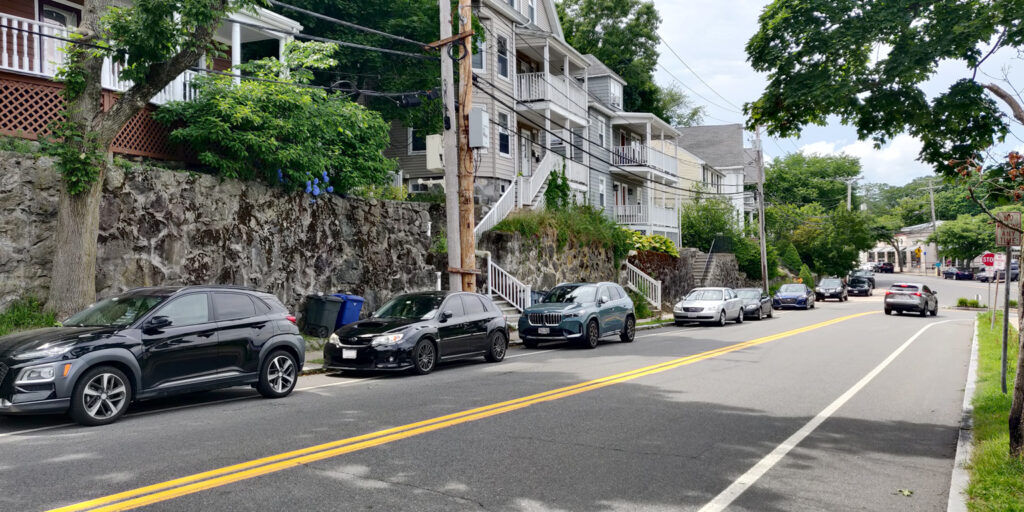
Conclusion
Ask your town leaders if they have a curb management strategy. Is the Town using its limited curb space in support of goals such as green infrastructure, public safety and accessibility, public transportation, local business, and car-light development?


In a 2019 study, MAPC found that:
- Three out of ten spaces sit empty during peak demand
- The key factors that drive parking demand are parking supply, transit accessibility and the percentage of deed-restricted units
This study raises important questions about the wisdom of continuing to commit large sections of the land area of our municipalities to be on reserve for parking cars. Such extra space could be used to benefit the open space, environmental sustainability and the need for more housing.
In 2015 Town Meeting approved the Master Plan. Following is the Housing chapter of that plan. It contains a great deal of information about details of the housing situation in Arlington, challenges of housing price increases, needs for specialty housing, opportunities for meeting these needs, etc. The authors found that “most cities and towns around Arlington experienced a significant rise in housing values from 2000 to 2010. A 40 percent increase in the median value was fairly common. However, Arlington experienced more dramatic growth in housing values than any community in the immediate area, except Somerville. In fact, Arlington’s home values almost doubled.” This and related data helps explain why the need for affordable housing is now so acute.